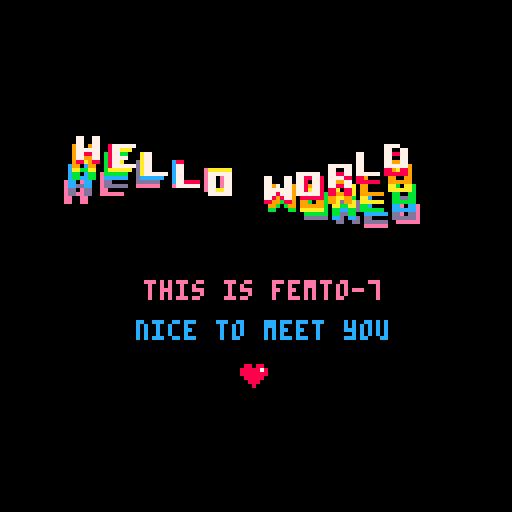Projects
FEMTO-7: PICO-8-like Standalone Library for C/C++
I really love the look and feel of the PICO-8 fantasy console; with its extremely limited 128x128 resolution and 16-colour fixed palette, those low-fidelity constraints prove ideal for encouraging the PICO-8 game developer to be especially creative and inventive.
What I'm less keen on, is programming in Lua. Honestly, I don't think learning to code and program in Lua is a terrible thing to do, it's just that I would far rather invest my time and effort continuing to code simple game prototypes in languages with which I am more familiar... like C/C++ (or JavaScript).
And then, if a game's mechanics appear promising and I decide to make a full-fledged game, I can easily re-use significant quantities of the code that I will have already written.
Enter stage left: FEMTO-7!

FEMTO-7 is my standalone PICO-8-like library for C/C++. It uses raylib to provide fantasy console functionality on Linux and Windows.
Currently implemented functions include:
- abs() - returns the absolute value of a number
- atan2() - calculates the arctangent of dy/dx
- btn() - test if a button is being pressed at this moment
- btnp() - test if a button has just been pressed,
with keyboard-style repeating - ceil() - returns the nearest integer at or above a number (its "ceiling")
- circ() - draw a circle shape, without fill
- circfill() - draw a filled-in circle shape
- cls() - clear the graphics buffer
- color() - set the draw colour in the draw state
- cos() - calculates the cosine of an angle
- cursor() - set the left-margin cursor position for print()
- flip() - copy the graphics buffer to the screen, then synchronise to the next frame at 30 frames per second
- flr() - returns the nearest integer at or below a number (its "floor")
- line() - draw a line between two points
- map() - draw a portion of the map to the graphics buffer
- max() - returns the maximum of two numbers
- mget() - gets the sprite number assigned to a cell on the map
- mid() - returns the middle of three numbers
- min() - returns the minimum of two numbers
- mset() - sets a cell on the map to a new sprite number
- music() - plays a music pattern, or stops playing
- pal() - change the draw state so all instances of a given colour are replaced with a new colour
- palt() - change the transparency of a colour in the draw state for subsequent draw calls
- pget() -
get the colour value of a pixel at the given coordinates - print() - print a string of characters to the screen
- printh() - prints a string to a console window that is running FEMTO-7
- pset() - set a pixel in the graphics buffer
- rect() - draw an empty rectangle shape
- rectfill() - draw a filled-in rectangle shape
- rnd() - generates a random number under the given limit,
or returns a random element from a sequence - sfx() - plays a sound effect
- sget() - gets the colour value of a pixel on the sprite sheet
- sgn() - returns the sign of a number
- sin() - calculates the sine of an angle
- spr() - draw a sprite, or a range of sprites, on the screen
- sqrt() - calculates the square root of a number
- srand() - initialises the random number generator with an explicit seed value
- stat() - returns information about the current runtime environment
- t() - alias of time()
- time() - returns the amount of time since FEMTO-7 was last started
FEMTO-7 can even be compiled to a shared or dynamic library for Linux (libf7.so) and Windows (libf7.dll) and accessed from a whole host of other programming languages using FFI. Bindings already exist for Deno, an alternative runtime for JavaScript.
I plan on releasing an early access version of FEMTO-7 on itch.io soon.
